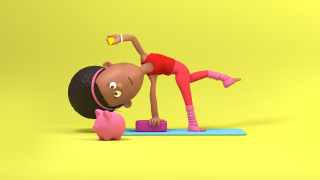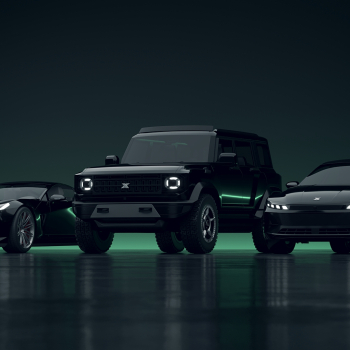
If you’re anything like me, then when someone mentions CGI you’ll think of dragons, superheroes, or some kind of slow-motion explosion – and that’s no surprise, Hollywood made it famous. But today, CGI and 3D visuals have gone beyond big screens. They’ve become powerful tools for brands, marketers, and creators looking to grab attention and build richer experiences.
We’re talking photorealistic product renders you can spin in 3D, brand worlds that couldn’t exist otherwise, and new homes you can tour from your sofa. Why does it work? It’s content with stopping power. Storytelling hits harder when you can see it, feel it, interact with it. And in a digital landscape full of short attention spans, that kind of impact matters.
So if you’re launching something new, finding a new way to tell your brand’s story, or just trying to put more oohs and aahs into your customer journey, you’ll want to think about CGI and 3D content. Let’s take a closer look.
While CGI (Computer-Generated Imagery) refers to visuals made using computer software, rather than traditional cameras or hand-drawing, 3D design gives flat visuals depth and volume – making them feel more lifelike and immersive. The result? A toolkit that brands can use to tell better stories and showcase their offerings in more engaging ways:
3D rendering - This refers to high-quality, photorealistic visuals of products, packaging, or environments. Ideal when something doesn’t exist yet or needs to adapt to different scenes, angles, or applications.
Image

Interactive 3D models - Think digital window shopping, but better. Users can explore products from every angle, zoom in and gain a more complete understanding of what’s on offer.
Brand mascots - Professional or playful, custom characters can enhance your brand personality and help build emotional connection.
Image

360° Videos and Virtual Tours - Ideal for real estate, hospitality, care, or any space that’s better explored than explained.
Customisable Experiences - Let users configure colours, materials, or features in real time. Great for products with lots of options – like sheds, cars or shoes – and proven to boost engagement.
Image

Animations - A product explainer, a process walkthrough, or a cinematic brand story, animations make complex ideas simple and static concepts dynamic.
Architectural CGI - Brings blueprints to life. Use it to pitch developments, market properties, or get stakeholder buy-in with visuals that feel real before anything’s built.
Image

They invite interaction.
When users can rotate, zoom, customise, or explore, they’re involved. That interactivity builds connection and increases dwell time. Web-based interactive 3D models, configurators, and immersive tours can help customers make more confident decisions.
They’re cost-effective.
CGI eliminates the need for reshoots or physical prototypes. Update once, use everywhere.
They’re incredibly flexible.
From digital ads to in-store screens, one 3D asset can be reused and repurposed across campaigns and platforms.
They grab attention fast.
Eye-catching visuals stop the scroll. Think of larger-than-life stunts like the viral Maybelline mascara buses rolling through city streets or Big Ben rocking a North Face puffer.
They’re memorable.
Novel visual content is more likely to stick in your audience’s mind — which is exactly where you want your brand to be.
They simplify complex ideas.
Whether it’s a technical process or an abstract concept, CGI and animation help explain it in a way that’s both clear and compelling.
They can be as creative as you are.
Want to showcase a product on the moon? Why not! There are no physical limits – if you can imagine it, CGI artists can build it.
Image

Let’s address the elephant in the room: AI. Yes, it’s here, it’s powerful, and it’s shaking things up – but it’s not about to replace that human touch. At least not in the way many fear.
AI isn’t a creative genius. It doesn’t have intuition or taste, and it doesn’t understand your brand’s values, your audience’s needs, or why certain visual choices matter. One of the biggest challenges with AI is a lack of control. While it can generate ideas quickly, the results can be inconsistent, off-brand, or just not quite right. And when everyone’s using the same tools trained on the same data, the outputs can start to feel a little generic.
It also can’t effectively interpret the huge variety of files that often come with visualisation projects. Whether that’s CAD files, reference photos or rough sketches – it still requires a human touch to see the bigger picture.
Where AI does excel is in generating rough concepts and handling repetitive or time-consuming tasks. Need a quick visual to support a brief, align your team on a particular 3D style, or create a base image to sketch over? AI can get you there quicker.
When used wisely, AI can improve the creative process and enable teams to work faster and smarter. Rather than replacing human creativity, it’s becoming a smart sidekick that helps artists and designers explore more ideas with more efficiency.
What is CGI?
Computer-Generated Imagery – visuals made entirely using computer software, not hand-drawn or filmed with a camera.
What is 3D in visual design?
3D adds depth and realism, making visuals more dynamic and interactive than flat 2D images.
Can I use CGI on my website?
Absolutely. With modern tools and hosting solutions, 3D and CGI content can be fast-loading, responsive, and SEO-friendly.
Is CGI expensive?
It can be upfront – but it’s really cost-effective over time. A single CGI asset can be reused, re-rendered, and repurposed across platforms without needing costly reshoots or prototypes.
Do I need to have 3D files or CAD models to start?
No. While existing files help, most 3D and CGI work can start from photos, sketches, or even written descriptions.
Can CGI be used for marketing before a product is finished?
Yes – and that’s one of its biggest advantages. You can start building buzz, get pre-orders, or show investors something tangible before anything is manufactured.
Is 3D content mobile-friendly?
Definitely. Interactive 3D models and lightweight renders can be optimised for mobile, ensuring smooth performance and fast load times.
Can CGI and 3D improve e-commerce conversion rates?
Yes. Studies show interactive 3D models increase time on page, reduce returns, and improve buyer confidence – especially for complex or high-ticket items.










